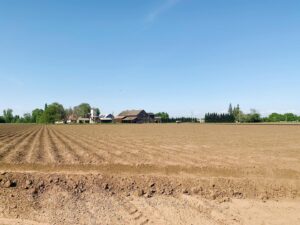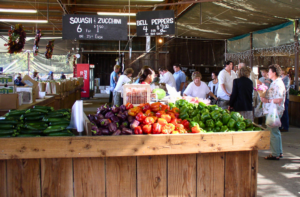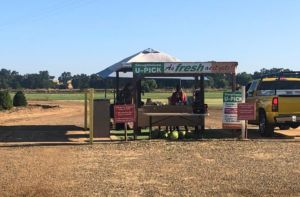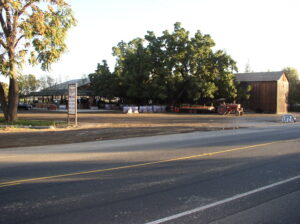Growing Together Spring 2024
Sweet Corn’s Just One of the Stars at Davis Ranch
Davis Ranch had, in some ways, a literal storybook beginning. Rick Grimshaw’s great-great-great grandfather traveled at times with the ill-fated Donner Party on his way to California during the early Gold Rush in the 1840s. A century later in a trek straight from The Grapes of Wrath, Ed Davis traveled halfway across the continent during the Dust Bowl from western Oklahoma in search of prosperity in the Sacramento Valley’s oil fields, a trip during which “he, his father, uncle and all the family members got on a two-ton truck and drove out here from Oklahoma, fixed 21 flat tires and had their dog run away.”

Davis didn’t last in those oil fields, so he turned to agriculture, ultimately laying the groundwork for what is Davis Ranch today. Generations later, his successors got their introduction to agriculture in tomato production. What was once a job for young Grimshaw — then a “kid with big plans” — turned into a homecoming of sorts later in his own career as a heavy machinery mechanic and maintenance technician when he became the primary operator of the farm covering land that had long been owned by both his and the Davis family.
Davis and his family, including sons Jim and Don, had spent decades building up the ranch — including a roadside stand where the family sold its trademark product, sweet corn — and diversifying its production to a range of vegetable crops. And Grimshaw was never far off.
“It’s been a progression over the years. Ed started out with two acres of corn and a table with signs. Ever since then, they’ve continued to grow and diversify,” said longtime Walnut Grove-based Grow West Service Manager Gary Fenocchio, who’s worked with Davis Ranch since the early 1980s. “I have watched it develop so much over the years, and it’s been a long progression. They are such friendly people, very kind, and deserve all the credit for being progressive and making smart decisions to be such a self-sufficient operation.”
Growing a farm business together
In 1992, Grimshaw and his childhood friends the Davis brothers became business partners when they bought what would soon become Davis Ranch, combining its output with the 70 acres his own family owned near Sloughhouse. Since then, they’ve taken the operation in different directions — building upon a strong foundation with different crops and markets, some that have worked and others that haven’t — as a way to continue to evolve and change, ultimately alleviating the pressure that growers like them normally face in finding success in growing from year to year and generation to generation.
“I was starting to look for a job somewhere else and Ed Davis said he wanted to retire but couldn’t if he didn’t have somebody to help run the operation. He said he’d give me one third of it if I would pay him for the equipment and run the business,” Grimshaw said. “I kicked it around a bit and thought ‘I don’t have anything to lose. Why not?’ So we bought it from Ed and named it Davis Ranch.”
Sweet corn was and remains a mainstay at Davis Ranch. Fenocchio describes the operation’s acreage as mostly sandy river bottom ground that in years like 2023 is prone to flooding. He provides Grimshaw, Davis and their team anhydrous ammonia, starter fertilizer and urea ammonium nitrate (UAN) 32 that’s sidedressed on corn and other vegetable crops.
“We plant in stages, about every two days. That enables us to harvest when the quality is highest,” said Grimshaw, whose Grow West PCA Brett Schmitz describes as the “true boots on the ground” at Davis Ranch. “Sweet corn can go from perfect to too old in a hurry, so this way, we can offer the best quality for the longest period of time.”
As one of the region’s only roadside stands offering sweet corn, Davis Ranch is a popular location for not just travelers who happen upon the roadside stand but also as a local, cost-efficient source of the food staple.
“Everyone wants quality, dependable produce. Once their customers get used to stopping there on their way home from work, they know they’re going to get a quality product with good service and a nice atmosphere,” said Fenocchio, who’s worked with Grow West since 1979. “They have a fantastic location and they have a great reputation for quality produce. Word gets around.”

Diversifying production to meet local demand
Ed had already added different produce to the farm’s staple of sweet corn like tomatoes, cantaloupes and watermelons, as well as Christmas trees, prior to Grimshaw and Ed’s two sons taking over the operation. Continuing to make such changes to meet local demand was nothing new to Ed’s sons who sought to continue the already decades-long legacy of providing a range of fresh produce for local buyers.
“We started testing the waters, adding squash, cucumbers and green beans, then fall produce like pumpkins. We did add onions and potatoes for a while but didn’t have the equipment to harvest them. It just made us realize we had a niche with sweet corn and a few other products,” Grimshaw said. “Then about 10 years ago, my business partner Jim Davis’ wife started a nonprofit to get people to come out and hand-harvest produce to get it out of the field and to food pantries and churches.”
That nonprofit gave Grimshaw an idea, one that is today a major part of the Davis Ranch business. A U-pick operation kills two birds with one stone; first, it helped minimize fruit and vegetable waste from spoilage in the field. It also added a new revenue stream with a few simple additions. During each growing season, Davis Ranch opens to customers who drive over vehicle scales to weigh their vehicles, then pick produce themselves. They’re charged on a per-pound basis after crossing the scales again upon leaving. U-pick customers must buy a minimum of $100 in produce, with the average buyer spending between $100 and $180.
“I got to thinking that we should be getting something out of this! The amount of produce we sold that first year really opened my eyes. It really took off, and it’s a big part of our business now,” Grimshaw said of the Davis Ranch U-pick operation. “There are times when traffic is bumper-to-bumper, and we might have 400 to 500 cars a day during the busy times.”
Why the Davis Ranch U-pick operation works
In addition to trimming waste and opening up new revenue for Davis Ranch, the U-pick operation serves a massively important purpose for local residents. The local area’s large concentrations of first-generation immigrants from countries like Russia, Ukraine and Vietnam represent a major market opportunity for Davis Ranch. Those segments of the local population now have access to fresh ingredients that are staples in their home countries, all at low costs. Though the Davis Ranch U-pick does have frequent visitors who buy smaller amounts, they more so use the experience to educate young people on the origins of food.

“These first-generation immigrant families who come out often can and preserve what they pick, so they can save a lot of money and get exactly what they want. We also have a lot of people who just want to show their kids where their food comes from,” Grimshaw said. “We have had some cars come out and pick eggplant, and when they leave, they have eggplant in every single nook and cranny of their cars.”
Reflecting on the past and future of Davis Ranch
Grimshaw admits there’s been a lot of trial and error in the years he’s worked at and managed Davis Ranch along with his business partners and workers. Both he and the Davis family have faced tragedy. The premature loss of predecessors and those who would have become successors of the business have caused abrupt changes in how the business has changed and evolved over the years to remain a release valve on the pressure that normally accompanies a diversified family operation. Despite such forced changes, Davis Ranch stakeholders have been quick to make the changes necessary to alleviate the pressure to grow farm productivity and continue to meet customer needs.
“We went full-face stumbling into this. We knew we had a niche with the farm stand and were able to build it up from there,” Grimshaw said. “We’ve been through tragedy, but this place has been in our blood. We know the area really well and are able to stay flexible to do what we need to do to raise what people buy here.”
Now, Grimshaw and the Davis brothers have crossed a different milestone in their journey at Davis Ranch. Recognizing it was time for a new generation to take its reins, the trio sold the operation in 2022. Buyer Eduardo Gomez, along with business partner Ricardo Zepeda Gomez, is no stranger to Davis Ranch, having been working in agriculture in the Sloughhouse area for decades, most recently in the seed corn business. In their first year managing the business, they will take the reins and continue the legacy started by the Davis family on Grimshaw land decades ago.

“Eduardo and Ricardo are gung-ho guys. While they will be running the operation, we’ll be here to help with whatever they need,” Grimshaw said, looking ahead to the 2024 growing season. “It was destined to happen. I just want it to keep going. I don’t want it to change. We just needed some new blood to make this thing go.”
Find out more about Davis Ranch.
